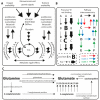Current Status and Future Prospects of Clinically Exploiting Cancer-specific Metabolism-Why Is Tumor Metabolism Not More Extensively Translated into Clinical Targets and Biomarkers?
- PMID: 30893889
- PMCID: PMC6471292
- DOI: 10.3390/ijms20061385
Current Status and Future Prospects of Clinically Exploiting Cancer-specific Metabolism-Why Is Tumor Metabolism Not More Extensively Translated into Clinical Targets and Biomarkers?
Abstract
Tumor cells exhibit a specialized metabolism supporting their superior ability for rapid proliferation, migration, and apoptotic evasion. It is reasonable to assume that the specific metabolic needs of the tumor cells can offer an array of therapeutic windows as pharmacological disturbance may derail the biochemical mechanisms necessary for maintaining the tumor characteristics, while being less important for normally proliferating cells. In addition, the specialized metabolism may leave a unique metabolic signature which could be used clinically for diagnostic or prognostic purposes. Quantitative global metabolic profiling (metabolomics) has evolved over the last two decades. However, despite the technology's present ability to measure 1000s of endogenous metabolites in various clinical or biological specimens, there are essentially no examples of metabolomics investigations being translated into actual utility in the cancer clinic. This review investigates the current efforts of using metabolomics as a tool for translation of tumor metabolism into the clinic and further seeks to outline paths for increasing the momentum of using tumor metabolism as a biomarker and drug target opportunity.
Keywords: biomarker; cancer; drug discovery; metabolic homeostasis; metabolism; metabolomics; translational medicine; tumor.
Conflict of interest statement
The authors declare no conflict of interest.
Figures


Similar articles
-
Drug discovery strategies in the field of tumor energy metabolism: Limitations by metabolic flexibility and metabolic resistance to chemotherapy.Biochim Biophys Acta Bioenerg. 2017 Aug;1858(8):674-685. doi: 10.1016/j.bbabio.2017.02.005. Epub 2017 Feb 16. Biochim Biophys Acta Bioenerg. 2017. PMID: 28213330 Review.
-
Metabolomics in cancer biomarker discovery: current trends and future perspectives.J Pharm Biomed Anal. 2014 Jan;87:1-11. doi: 10.1016/j.jpba.2013.08.041. Epub 2013 Sep 14. J Pharm Biomed Anal. 2014. PMID: 24091079 Review.
-
Translational metabolomics in cancer research.Biomark Med. 2015;9(9):821-34. doi: 10.2217/bmm.15.52. Epub 2015 Sep 1. Biomark Med. 2015. PMID: 26329905 Free PMC article. Review.
-
New Metabolomic Insights Into Cancer.Cancer J. 2024 Sep-Oct 01;30(5):301-306. doi: 10.1097/PPO.0000000000000740. Cancer J. 2024. PMID: 39312449 Free PMC article. Review.
-
Metabolomics studies in gastrointestinal cancer: a systematic review.Expert Rev Gastroenterol Hepatol. 2020 Jan;14(1):9-25. doi: 10.1080/17474124.2020.1700112. Epub 2019 Dec 3. Expert Rev Gastroenterol Hepatol. 2020. PMID: 31786962
Cited by
-
GLUL Ablation Can Confer Drug Resistance to Cancer Cells via a Malate-Aspartate Shuttle-Mediated Mechanism.Cancers (Basel). 2019 Dec 5;11(12):1945. doi: 10.3390/cancers11121945. Cancers (Basel). 2019. PMID: 31817360 Free PMC article.
-
Omics Potential in Herbicide-Resistant Weed Management.Plants (Basel). 2019 Dec 14;8(12):607. doi: 10.3390/plants8120607. Plants (Basel). 2019. PMID: 31847327 Free PMC article. Review.
-
Untargeted metabolomic and lipidomic analyses reveal lipid dysregulation in the plasma of acute leukemia patients.Front Mol Biosci. 2023 Nov 10;10:1235160. doi: 10.3389/fmolb.2023.1235160. eCollection 2023. Front Mol Biosci. 2023. PMID: 38028534 Free PMC article.
-
Ovarian Cancer Biomarkers: Moving Forward in Early Detection.Adv Exp Med Biol. 2020;1219:355-363. doi: 10.1007/978-3-030-34025-4_18. Adv Exp Med Biol. 2020. PMID: 32130708 Review.
-
Advances in Ultra-High-Resolution Mass Spectrometry for Pharmaceutical Analysis.Molecules. 2023 Feb 22;28(5):2061. doi: 10.3390/molecules28052061. Molecules. 2023. PMID: 36903305 Free PMC article. Review.
References
Publication types
MeSH terms
Substances
Grants and funding
LinkOut - more resources
Full Text Sources
Other Literature Sources

